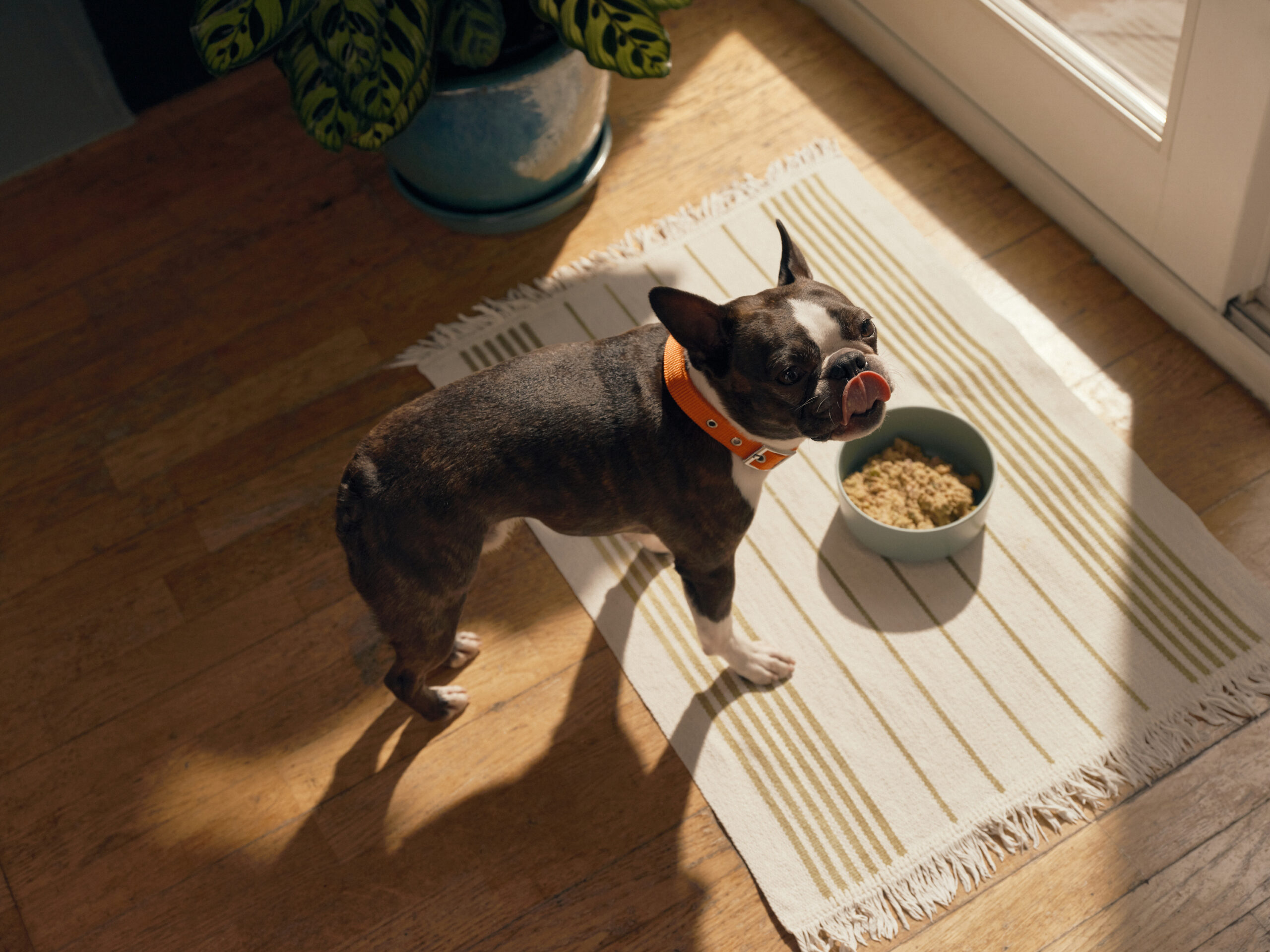Hey Ollie blog readers! We’re offering you an exclusive 60% OFF your starter box! Try now!
Your dog’s ears do more than just make them look adorable. They’re also sensitive, complex, and, unfortunately, prime real estate for tiny, uninvited pests.
If your dog has been shaking their head, scratching nonstop, or you’ve noticed dark gunk coming from their ears, ear mites could be the culprit.
Ear mites in dogs are incredibly common—especially in puppies, rescue dogs, and pets who spend time around other animals. These microscopic parasites can cause serious irritation, inflammation, and even secondary infections if left untreated.
But the good news? Once you know the signs and how to treat them, ear mites are totally manageable.
In this guide, we’ll cover:
- What ear mites in dogs actually are
- How dogs catch them
- Signs your dog might have them
- Vet-recommended ear mite treatment for dogs
- How to prevent reinfestation—and keep your dog’s ears clean and healthy long-term
You’ll also learn how supporting your dog’s immune system with clean, whole foods, like Ollie fresh, gently cooked meals, can play a role in their recovery and prevention.
Let’s get into what ear mites really are, and why they’re such a common (and itchy) problem.
What Are Ear Mites in Dogs?
Ear mites are tiny parasites that live in the ear canal and feed on skin debris and wax. The most common type found in dogs is called Otodectes cynotis—and while they’re microscopic, the problems they cause are anything but small.
These mites crawl around inside your dog’s ears, causing intense itching and irritation. Left untreated, they can lead to:
- Redness and swelling
- Open sores from scratching
- Secondary ear infections
- Damage to the ear canal or eardrum in severe cases
They’re highly contagious—especially among dogs, cats, and other small mammals. That’s why ear mites in dogs are often seen in:
- Puppies
- Shelter or rescue animals
- Dogs in close contact with other pets (boarding, daycare, dog parks)
Despite sometimes being called “ear lice in dogs,” ear mites are not lice. They’re arachnids, more closely related to ticks and spiders than fleas or lice. Either way, they’re not something you want hanging around your dog’s ears.
According to PetMD, ear mites account for roughly 50% of ear infections in puppies, which makes them one of the leading causes of ear-related vet visits.
If your dog has been unusually itchy or uncomfortable around their ears, ear mites might be the reason. But how do they get them in the first place?
How Do Dogs Get Ear Mites?
You keep your dog clean. You wash their bedding. You do your best to keep fleas and ticks away. So how does a dog get ear mites?
The short answer: from other animals.
Ear mites spread through direct contact. If your dog plays, snuggles, or shares space with another pet that’s carrying mites, they can easily pick them up. This makes environments like:
- Dog parks
- Kennels and boarding facilities
- Animal shelters
- Grooming salons
- Multi-pet homes
And here’s the tricky part: some pets can carry mites without showing symptoms. That means your dog might catch them from a seemingly healthy friend.
Ear mites can also live for a short time on objects like:
- Bedding and blankets
- Brushes and combs
- Collars and harnesses
- Furniture or rugs in shared spaces
That’s why treating just one pet often isn’t enough, all animals in the home may need treatment, even if they’re not scratching.
Puppies and dogs with weaker immune systems are more vulnerable, too. That’s one reason we always recommend supporting your dog’s health from the inside out with clean, nutrient-rich food, like Ollie fresh recipes, made to support immune function and overall well-being.
How Do I Know If My Dog Has Ear Mites?
Your dog can’t tell you their ears are driving them crazy—but their behavior says plenty. The most obvious sign of ear mites in dogs is constant, intense itching. But there are other red flags to watch for.
Common Signs of Ear Mites in Dogs:
- Frequent head shaking
- Scratching at the ears, neck, or face
- Dark brown or black discharge that looks like coffee grounds
- Redness and swelling inside the ears
- Crusty buildup around the ear opening
- Strong, musty odor from the ears
- Rubbing ears on the floor or furniture
- Whimpering or sensitivity when you touch their ears
In more severe cases, dogs can develop open wounds, scabs, or even damage to the eardrum from too much scratching.
Ear Mites vs. Ear Infections: How to Tell the Difference
Ear infections can look a lot like mite infestations—but they’re caused by bacteria or yeast, not parasites. The symptoms are similar, but infections may come with:
- More discharge
- Stronger odor
- Pain when chewing or yawning
- Fever or signs of overall illness
You won’t be able to see the mites without a microscope, so don’t guess. If you suspect ear mites or an infection, it’s time to visit the vet.
How Vets Confirm the Diagnosis
- Ear exam with an otoscope to check for inflammation or damage
- Microscopic exam of ear swab to spot mites or eggs
- In some cases, your vet may also test for secondary infections
A quick, simple swab can tell your vet exactly what’s causing the problem—and get your dog on the right treatment fast.
Ear Mite Treatment for Dogs
Once your vet confirms that your dog has ear mites, the good news is that treatment is usually fast and effective. But to truly get rid of the mites—and stop them from coming back—you’ll need to treat your dog, their ears, and everything they’ve come into contact with.
Here’s how that typically looks:
Veterinary Treatments That Work
Most vets recommend prescription products that are safe, fast-acting, and proven to kill mites at all life stages.
Common options include:
- Topical spot-on treatments like selamectin (Revolution) or moxidectin
- Prescription ear drops that contain antiparasitic ingredients
- Oral medications in more severe or widespread cases
These treatments often need to be repeated once or twice, depending on the product and your vet’s advice. Many are also effective against fleas and ticks, which makes them a good long-term solution for prevention, too.
Ear Cleaning Is a Must
Before applying any treatment, your vet may clean your dog’s ears to remove wax, debris, and mites. At home, you may be asked to:
- Use a vet-recommended ear rinse
- Gently massage the base of the ear
- Wipe away loosened debris with a soft cloth or cotton pad (never deep inside the ear canal)
Keeping the ears clean helps medications work better and reduces the risk of secondary infections.
Clean the Environment (and Other Pets)
Ear mites are highly contagious. To stop reinfection, you’ll also need to:
- Wash your dog’s bedding, blankets, and toys in hot water
- Vacuum furniture and rugs
- Treat all pets in the household, even if they’re not showing symptoms
Support Recovery from the Inside Out
Your dog’s immune system plays a key role in fighting off parasites and preventing future flare-ups. That’s why we always recommend feeding a clean, fresh diet during and after treatment.
Ollie fresh, gently cooked meals are rich in real protein, essential fatty acids, and anti-inflammatory nutrients—all important for supporting skin health and a balanced immune response.
How to Get Rid of Ear Mites in Dogs at Home (Safely)
If your vet has confirmed the diagnosis and your dog’s case is mild, you may be able to manage part of the treatment at home. But keep in mind: ear mites are tough to eliminate completely without the right medication, and untreated infestations can get worse quickly.
Here’s what’s safe to do at home—and what to steer clear of.
What You Can Do (With Vet Guidance)
1. Clean the Ears Gently
- Use a vet-approved ear cleaner made specifically for dogs
- Squeeze solution into the ear canal, massage the base, and let your dog shake
- Wipe excess debris with a soft cotton pad or gauze
- Avoid using cotton swabs inside the ear canal—they can push mites and debris deeper
Repeat as often as your vet recommends—usually once or twice daily during treatment.
2. Apply Prescribed Medications at Home
- Follow instructions carefully for topical treatments or ear drops
- Be consistent: missing doses can let the mites repopulate
- Treat every pet in your household—even cats—if your vet advises it
3. Clean Everything Your Dog Has Touched
- Wash bedding, toys, and collars in hot water
- Wipe down hard surfaces
- Vacuum rugs, couches, and car interiors if your dog rides along
Mites can survive for several days outside the body, so this step matters.
What You Shouldn’t Do
Don’t Try DIY Remedies
- Homemade solutions like oils, vinegar, or hydrogen peroxide can irritate your dog’s ears and make the problem worse
- Essential oils can be toxic to dogs, especially in concentrated forms
Don’t Delay Treatment
- Mites reproduce fast. Waiting too long can lead to infections, ear damage, or even hearing loss in severe cases
How to Prevent Ear Mites in the Future
Once you’ve gone through the trouble of treating ear mites in your dog, the last thing you want is a repeat. The good news is, keeping them away is totally doable—with a few smart habits and the right daily support.
1. Keep Ears Clean—But Not Too Clean
Routine ear care goes a long way. Use a gentle, vet-approved cleaner once a week—or as often as your vet recommends.
Avoid over-cleaning, though. Stripping away too much wax can dry out the ear canal, creating irritation that mites (and infections) love.
2. Wash Bedding and Shared Items Regularly
Since mites can survive for several days in the environment, it helps to:
- Wash your dog’s bedding in hot water weekly
- Disinfect toys, grooming tools, and food bowls
- Vacuum rugs and couches—especially in multi-pet homes
If your dog shares space with a cat, remember: cats can carry the same mites, even without symptoms.
3. Use Monthly Parasite Prevention
Many flea and tick preventatives—like selamectin and moxidectin—also protect against ear mites. Ask your vet which product is best for your dog’s age, size, and lifestyle.
This is especially helpful if your dog frequents daycares, parks, or grooming salons.
4. Feed for Immune Support, Not Just Fullness
Your dog’s immune system helps fight off parasites before they cause full-blown problems. Supporting that system starts with real food—not fillers.
Ollie fresh meals are packed with the good stuff:
- Real, gently cooked proteins
- Anti-inflammatory omega-3s
- Vitamins and minerals from whole foods
Dogs with strong immune health are more resilient—not just to ear mites, but to everything from skin infections to seasonal allergies.
5. Check Their Ears Weekly
Early signs of trouble include:
- More scratching than usual
- Wax buildup or black debris
- Head shaking or odor
The earlier you spot something, the faster (and easier) it is to treat.
FAQs About Dog Ear Mites
- How do I know if my dog has ear mites or an ear infection?
Both can cause itching, head shaking, and ear discharge. But ear mites usually create a dry, dark, crumbly debris that looks like coffee grounds. Infections often have a stronger odor and more moist or yellowish discharge. A vet exam is the only way to be sure.
- Are ear mites contagious to humans?
Very rarely. Ear mites in dogs don’t usually affect people, but they can be passed between pets, especially to cats. That’s why it’s important to treat all household animals.
- Can ear mites go away on their own?
No. Ear mites won’t clear up without treatment. Left untreated, they can lead to chronic inflammation, infections, or even damage to your dog’s hearing.
- What’s the best ear mite treatment for dogs?
Prescription treatments from your vet, like selamectin, moxidectin, or medicated ear drops—are the most effective. OTC treatments exist, but they don’t always eliminate mites at all life stages.
- How long does it take to get rid of ear mites in dogs?
With proper treatment, most infestations clear up in 1–3 weeks. However, follow-up cleaning and retreatment are often needed to make sure all mites and eggs are gone.
- Can diet help prevent ear mites?
Absolutely. A strong immune system helps your dog resist parasites. Ollie’s fresh, nutrient-rich recipes support skin health and immunity with high-quality protein and anti-inflammatory ingredients.
Tagged As:

The nutrition your dog needs,
the food they want.

Enjoying our articles? Subscribe our Newsletters and get new articles directly to your inbox
You might also like
30 July 2025
6 MINS READ
Fresh Dog Food for Picky Eaters: A Tasty Solution
Feeding a picky eater can feel like an unsolvable riddle. One day your dog is happily chowing down, and the next, they turn their nose up at the exact same food. If you’ve found yourself trying …
by Ollie Pets
30 July 2025
6 MINS READ
Top Nutrition Tips for Dogs with Digestive Issues
Watching your dog struggle with an upset stomach, diarrhea, or gas is difficult for any pet parent. Digestive issues are common, but the good news is that the right nutrition can make a world of d…
by Ollie Pets
30 July 2025
6 MINS READ
Ingredients to Support Healthy Digestion for Dogs with Sensitive Stomachs
As a dog parent, seeing your pup struggle with gas, loose stools, or vomiting can leave you feeling helpless and worried. The good news is that one of the most powerful tools for managing a sensit…
by Ollie Pets







